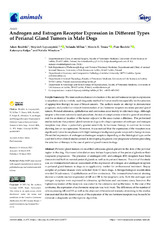Androgen and Estrogen Receptor Expression in Different Types of Perianal Gland Tumors in Male Dogs
Autor
Brodzki, Adam
Łopuszynski, Wojciech
Millán, Yolanda
Tatara, Marcin R.
Brodzki, Piotr
Kulpa, Katarzyna
Minakow, Natalia
Editor
MDPIFecha
2021Materia
Perianal gland tumorsMale dogs
Estrogen receptor
Androgen receptor
Immunohistochemistry
METS:
Mostrar el registro METSPREMIS:
Mostrar el registro PREMISMetadatos
Mostrar el registro completo del ítemResumen
Perianal gland tumors are modified sebaceous glands present in the skin of the perianal region in the dog. Hormonal stimulation may induce hyperplasia of the perianal glands or their neoplastic progression. The presence of androgen (AR) and estrogen (ER) receptors have been demonstrated both in normal perianal glands as well as in perianal tumors. The aim of the study was an immunohistochemical assessment of the expression of estrogen and androgen receptors in perianal gland tumors in dogs as an applicatory marker for antihormonal treatment. Biopsy samples of perianal masses were collected from 41 male dogs. A histopathological examination revealed 24 adenomas, 12 epitheliomas and five carcinomas. The immunohistochemical staining showed a mainly nuclear expression of AR and ER in the neoplastic cells. Both the androgen and estrogen receptors were expressed in adenoma, epithelioma and carcinoma cases; however, the highest expression of the receptors was stated in the adenoma and epithelioma. In the case of the carcinoma, the expression of sex hormone receptors was very weak. The differences of the number of cells expressing AR and ER as well as the observed differentiated intensity of staining in the studies demonstrated that the determination of the expression of the sex hormone receptors may be useful to elaborate a diagnostic and therapeutic algorithm.

